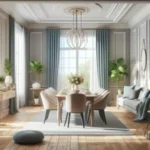The bedroom is more than just a place to sleep; it’s a sanctuary where we retreat at the end of a long day, a personal oasis that reflects our individuality and nurtures our well-being.
The color of your walls plays a pivotal role in shaping the atmosphere of this intimate space, influencing your mood, energy levels, and overall sense of tranquility. With a kaleidoscope of paint colors available, choosing the perfect hue can feel overwhelming. should you go for calming blues that evoke serenity, warm earth tones that bring comfort, or bold shades that inspire creativity? In this blog post, we’ll explore the psychology of color and how different shades can transform your bedroom into a harmonious retreat tailored to your personal style and emotional needs. Dive into the art of color selection with practical tips, expert insights, and inspiring ideas to help you master the mood of your sleeping space and create the bedroom of your dreams.
1. Understanding the Psychology of Color
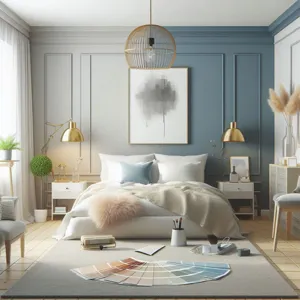
When it comes to selecting the perfect paint color for your bedroom, understanding the psychology of color is crucial. Colors evoke emotions, influence moods, and can significantly impact how we feel in a space. Each hue carries its own meaning and can either uplift or calm the spirit, making the choice of color a powerful tool in shaping the ambiance of your sanctuary.
Warm colors like reds, oranges, and yellows can generate feelings of warmth and energy, but they may not be the best choice for a bedroom meant for relaxation. Instead, consider cooler tones like soft blues and greens, which are known for their calming effects. These colors can create a serene environment, promoting tranquility and restful sleep.
Neutrals, such as soft grays, beiges, and whites, offer versatility and can serve as a perfect backdrop for layering textures and accents. They can make a space feel more open and airy, while enabling you to experiment with bolder decor elements without overwhelming the senses.
It’s also important to consider how lighting affects color perception in your bedroom. Natural light can enhance colors, making them appear brighter, while artificial lighting can alter their appearance in unexpected ways. Test swatches on your walls at different times of the day to see how the color transforms from morning to evening.
Ultimately, the key to mastering mood through paint color lies in aligning your choices with the feelings you wish to cultivate in your space. By understanding the psychology of color, you can create a bedroom that not only looks stunning but also nourishes your well-being and invites restful nights.
2. The Importance of Mood in Bedroom Design
When it comes to creating a sanctuary within your home, the mood of your bedroom plays a pivotal role in your overall well-being. The hues that envelop you upon entering the space can influence your emotions, affect your sleep quality, and even shape your daily mindset. Choosing the right paint color is not merely an aesthetic decision; it’s a powerful tool that can transform your bedroom into a serene retreat or an energizing haven.
Warm tones such as soft yellows and gentle peaches tend to evoke feelings of comfort and happiness, making them ideal for creating a cozy atmosphere that feels inviting at all times. These colors can mimic the warmth of sunlight, promoting a sense of cheerfulness that can uplift your spirits as you begin or end your day. On the other hand, cooler shades like tranquil blues and soothing greens are known for their calming effects. These colors can reduce anxiety and stress, fostering a peaceful environment conducive to relaxation and restful sleep.
Moreover, the saturation and brightness of a color can also affect the mood. Bright, bold colors can energize and inspire creativity, making them perfect for mornings, while muted and pastel shades can create a soft, nurturing atmosphere that encourages unwinding. The key is to consider the purpose of your bedroom — is it a space for restful sleep or a creative workspace? By aligning your color choices with your intended mood, you can significantly enhance your bedroom’s functionality.
In essence, understanding the psychological impact of color allows you to craft an environment that resonates with your personal style and emotional needs. As you embark on the journey of selecting the perfect paint color for your bedroom, remember that it’s not just about aesthetics; it’s about creating a mood that nurtures your spirit and enhances your quality of life. Whether you seek tranquility, vibrancy, or a balance of both, the right color palette can be the foundation for a harmonious bedroom retreat.
3. Factors to Consider Before Choosing a Color
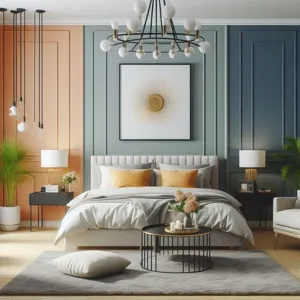
Choosing the perfect paint color for your bedroom is not just about aesthetics; it’s about creating an atmosphere that resonates with your personal style and emotional well-being. Before you dive into swatches and samples, there are several key factors to consider that can significantly influence your final decision.
**1. Room size and Lighting:** The dimensions of your bedroom and the quality of natural light it receives can dramatically affect how a color appears. Lighter shades can make a small space feel larger and more open, while deeper hues can create a cozy, intimate vibe. Pay attention to how the light shifts throughout the day—colors can look drastically different in morning light versus the warm glow of the evening. If your room is bathed in bright sunlight, consider colors that will complement this natural brightness, such as soft whites or pastel shades. Conversely, if your space lacks natural light, you might want to lean towards warmer tones to create a welcoming atmosphere.
**2. Personal Taste and Emotional Response:** Your own preferences play a pivotal role in your choice. Think about the colors that resonate with you personally. Do you feel calm and serene surrounded by cool blues and greens, or do you thrive in the energy of vibrant yellows and reds? Consider the emotional impact of colors—while blues and greens evoke tranquility, warm colors like reds and oranges can energize the space. It’s essential to select hues that not only align with your taste but also promote the mood you want to foster in your bedroom.
**3. Existing Decor and Furniture:** Take inventory of your bedroom’s existing decor, furnishings, and textiles. The color you choose should harmonize with these elements to create a cohesive look. If you have a statement piece, such as a colorful rug or a bold headboard, use that as your anchor while selecting a complementary wall color. Additionally, consider the finish of your furniture; for instance, a sleek modern bedroom set may be best paired with a contemporary palette, while vintage pieces could shine against softer, more muted tones.
**4. Trends vs. Timelessness:** While it’s tempting to jump on the latest color trends, think about how long you plan to keep your bedroom looking fresh. Trendy colors can quickly become outdated, so it might be wiser to choose a timeless palette that you won’t tire of after a season. If you want to incorporate trendy shades, consider using them as accents through accessories like throw pillows or artwork, allowing you the freedom to update your space without a complete overhaul.
By thoughtfully considering these factors, you’ll be better equipped to choose a paint color that not only beautifies your bedroom but also nurtures your overall well-being. Remember, the goal is to create a sanctuary—a space that reflects who you are and fosters relaxation and rejuvenation.
4. Assessing Your Personal Style and Preferences
When it comes to choosing the perfect paint color for your bedroom, understanding and embracing your personal style and preferences is essential. Your bedroom should be a sanctuary—a reflection of who you are and how you want to feel when you step inside. Take a moment to consider the elements that resonate with you: Are you drawn to the tranquility of soft pastels, or does the bold vibrancy of jewel tones speak to your adventurous spirit?
Begin by exploring your existing decor and furnishings. What colors dominate your space? If you have a favorite piece of art or a comfortable throw blanket that you adore, these can serve as excellent anchors for your color palette. Consider the textures and patterns in your room as well; a rich, textured fabric can create a striking contrast against a muted wall, adding depth and dimension to your design.
Next, think about the mood you want to create. Do you envision a serene retreat that promotes relaxation and restful sleep, or a vibrant, energizing space that inspires creativity? Colors can evoke powerful emotions, so take the time to experiment with different hues. For instance, soft blues and greens can foster calmness, while warm yellows and oranges can inject a sense of warmth and cheer.
Consider also how your personal style translates into color preferences. Are you a minimalist who prefers a neutral palette, or do you embrace a more eclectic approach with bold, contrasting colors? Use platforms like Pinterest to curate mood boards, or create physical swatches that reflect your style. By visualizing your ideas, you’ll be better equipped to choose a color that not only suits your personal taste but also harmonizes with the overall aesthetic of your bedroom.
Ultimately, the key is to trust your instincts. Your bedroom is a personal haven, and the colors you choose should resonate with you on a deep level. Spend time in your space with paint swatches, observing how each color interacts with the light at different times of the day. The right shade will not only enhance the beauty of your room but also create a nurturing environment where you can retreat, recharge, and find peace.
5. The Impact of Natural Light on Paint Colors
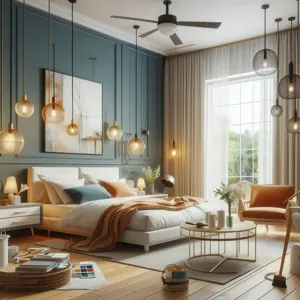
When it comes to choosing the perfect paint color for your bedroom, one of the most crucial factors to consider is the impact of natural light. The way a color appears can drastically change depending on the time of day, the direction your windows face, and the quality of natural light that filters through.
Morning light, often soft and warm, can breathe life into light blues or soft yellows, making them feel inviting and serene. On the other hand, harsh afternoon sun can wash out lighter shades, leaving them looking drab and unappealing. If your bedroom faces north, the light tends to be cooler and more subdued, which can make colors appear muted and less vibrant. In spaces with southern exposure, colors may seem more vivid and saturated due to the abundance of sunlight, while eastern-facing rooms may benefit from brighter hues in the morning light.
To truly understand how a paint color will behave in your bedroom, it’s essential to observe how it changes throughout the day. Test swatches on different walls and watch them during different times—early morning, midday, and late afternoon—to see how the interplay of light affects your chosen shade. Also, consider the type of light fixtures you use at night; incandescent bulbs can give a warm glow, while LED lights may render colors cooler.
Ultimately, the goal is to create a harmonious atmosphere that complements both the natural light and your personal style. By being mindful of how light interacts with your paint choices, you can craft a bedroom sanctuary that feels perfectly balanced and inviting at all hours of the day.
6. Popular Color Schemes for Bedroom Serenity
When it comes to creating a serene bedroom sanctuary, choosing the right color scheme is essential. Popular color schemes can significantly influence the mood of the space, promoting relaxation and tranquility. Here are a few timeless palettes that evoke a sense of peace and harmony:
**1. Soft Neutrals:** Shades of beige, taupe, and soft gray create a soothing backdrop that allows for versatility in decor. These colors are not only calming but also serve as a perfect canvas for layering textures, from plush linens to woven baskets. Adding a few accent pieces in darker hues can provide depth without overwhelming the senses.
**2. Cool Blues:** Inspired by the tranquility of the ocean and sky, soft blues and aquas work wonders in a bedroom setting. These shades are known for their calming effects and can help lower blood pressure, making them ideal for a restful retreat. Consider complementing light blue walls with white or sandy-colored accents to enhance the fresh, airy feel.
**3. Gentle Greens:** Nature-inspired greens, like sage or mint, can bring a refreshing touch to your bedroom. Green is associated with renewal and growth, and when applied in soft tones, it invites a sense of balance and harmony. Pairing these colors with natural wood elements or botanical prints can deepen the connection to the outdoors.
**4. Warm Earth Tones:** Rich browns, terracotta, and muted rust create a cozy ambiance, reminiscent of autumn. These colors are perfect for creating a warm, inviting space. When used thoughtfully, they can evoke feelings of comfort and stability. Combining these hues with soft textiles in creams or whites can help keep the atmosphere light and inviting.
**5. Serene Pastels:** Soft pastels like lavender, blush pink, or buttery yellow can infuse a sense of serenity and warmth into your bedroom. These playful yet calming colors offer a gentle touch that encourages relaxation. Consider using pastel shades for accent walls or in decorative accessories to create a dreamy environment without overwhelming the space.
Each of these color schemes provides a unique approach to achieving bedroom serenity. When selecting your palette, think about the emotions you want to evoke and how each color resonates with you personally. The goal is to create a space where you can unwind, recharge, and escape from the hustle and bustle of daily life.
7. Warm vs. Cool Colors: What Works Best?
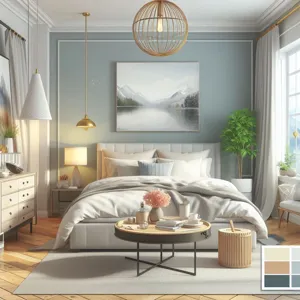
When it comes to selecting the perfect paint color for your bedroom, understanding the distinction between warm and cool colors is crucial, as each can dramatically influence the ambiance and mood of your personal sanctuary.
Warm colors—think soft reds, sunny yellows, and rich oranges—tend to evoke feelings of comfort and coziness. They can make a space feel inviting and energizing, perfect for those who want their bedroom to be a lively retreat. A warm-toned palette can mimic the glow of a sunset, creating a serene yet stimulating environment where you can unwind after a long day. For instance, painting your walls a warm peach or a muted terracotta can infuse your room with a sense of warmth, making it feel both intimate and welcoming.
On the other hand, cool colors like blues, greens, and purples instill a sense of calm and tranquility. These hues are reminiscent of nature—think of the soothing blue of the sky or the refreshing green of a forest. Cool colors can help create a peaceful atmosphere, making them ideal for a bedroom where relaxation is the priority. A serene light blue or a soft lavender can transform your space into a calming oasis, promoting restfulness and reflection, which is essential for a good night’s sleep.
When deciding between warm and cool colors, consider not only your personal preferences but also the overall mood you want to achieve. If your bedroom is a space for relaxation and rejuvenation, leaning towards cooler tones might be the best option. However, if you prefer a more vibrant, energizing atmosphere, warm colors could be your go-to choice. Remember, the lighting in your room will also play a significant role in how these colors appear; warm colors can appear more vibrant in natural light, while cool colors can enhance a cozy feel in dimmer settings.
Ultimately, the choice between warm and cool colors is about creating a bedroom that reflects your personality and meets your lifestyle needs. By understanding the emotional impact of these color families, you can make an informed decision that transforms your bedroom into the perfect retreat.
8. Using Accent Walls to Enhance Mood
Accent walls are a powerful design tool that can significantly enhance the mood of your bedroom while showcasing your personal style. By strategically selecting one wall to feature a bold or contrasting color, you can create a stunning focal point that draws the eye and sets the overall tone of the space. This technique allows for the introduction of vibrant hues without overwhelming the entire room, making it an ideal choice for those who may feel hesitant about fully committing to a bright color palette.
When considering your accent wall, think about the emotions you want to evoke. For instance, deep blues and greens can instill a sense of calm and tranquility, making them perfect for a restful retreat. On the other hand, warm tones like rich terracotta or sunny yellows can infuse your space with energy and positivity, perfect for those mornings when you need a little extra motivation.
Texture can also play a role in enhancing the mood of your accent wall. Consider using materials like reclaimed wood, textured wallpaper, or even a creative mural to add depth and interest. These elements not only add visual appeal but also contribute to the overall ambiance of the room, inviting warmth and a sense of comfort.
Finally, don’t forget to consider the surrounding decor and furnishings when choosing your accent wall color. A thoughtfully selected hue can complement existing pieces, bringing the entire room together in a cohesive and harmonious way. By using accent walls effectively, you can transform your bedroom into a sanctuary that reflects your personality and sets the perfect mood for relaxation and rejuvenation.
9. Testing Paint Samples: How and Why
Choosing the perfect paint color for your bedroom is no small feat, and testing paint samples is a crucial step in this transformative journey. The colors you envision in your mind may not always translate as expected once applied to your walls. This is where testing comes into play—giving you the opportunity to see how various shades interact with your space, lighting, and existing decor.
**How to Test Paint Samples**
Start by selecting a handful of colors that resonate with your vision for the room. Many paint stores offer sample pots, which are a cost-effective way to experiment without committing to a full gallon. Once you’ve narrowed it down, apply swatches of each color directly onto the walls you plan to paint. It’s best to paint a square foot or two of each sample to get a true sense of how the color will look in your space.
When applying the samples, consider the light in your room. Natural sunlight, artificial lighting, and even the time of day can dramatically alter how a color appears. That vibrant blue you loved in the store may seem icy in the morning light but warm and inviting during the golden hour. For the best results, observe the samples at different times of the day and in various lighting conditions.
**Why Testing Paint Samples is Essential**
Testing paint samples is not just about visual appeal; it also engages your emotional connection to color. Colors can evoke feelings and set the tone for your bedroom sanctuary. A calming lavender might make you feel relaxed and serene, while a lively coral could invigorate the space. By testing, you can hone in on not just any color, but the *right* color that will contribute to the atmosphere you wish to create.
Additionally, this step helps to mitigate the risk of buyer’s remorse. There’s nothing worse than investing time and money into painting your bedroom, only to find that the chosen color doesn’t deliver the desired effect. By taking the time to test samples, you empower yourself with knowledge and confidence in your decision.
In summary, paint samples are an invaluable tool in your quest for the perfect bedroom color. They allow you to visualize, experiment, and ultimately choose a shade that not only enhances the beauty of your space but also aligns with your personal style and emotional needs. So grab those sample pots, roll up your sleeves, and let the testing begin!
10. The Role of Texture and Finish in Color Perception
When it comes to selecting the perfect paint color for your bedroom, it’s essential to consider not just the hue itself but also the texture and finish that accompany it. The interplay between color and finish can dramatically influence the overall mood and atmosphere of your space.
A matte finish, for instance, often lends a soft, cozy feel to a room, absorbing light and creating a more intimate ambiance. This is particularly effective when using deeper, richer colors like navy blue or forest green, which can envelop a room in a serene embrace. Conversely, a satin or glossy finish reflects light, enhancing brighter shades such as crisp whites or sunny yellows, making your space feel more open and airy. This reflective quality can add a layer of vibrancy and energy, perfect for those who want to invigorate their mornings.
Texture also plays a crucial role in how we perceive color. A smooth, even surface can make colors appear more uniform and true to their essence, while a textured wall can introduce depth and complexity to the shade. For example, a lightly textured finish can soften a bold color, making it feel more approachable and warm.
Moreover, consider the materials in your bedroom—furniture, linens, and decor. A rich, velvety fabric can complement a soft pastel, while a sleek, modern finish can enhance bolder, contemporary colors. By thoughtfully combining paint finishes and textures, you not only craft a visually stunning environment but also curate a specific emotional response, ensuring that your bedroom is a true reflection of your personal style and mood.
So, as you embark on your journey to transform your bedroom, remember that the role of texture and finish is just as vital as the color choice itself. Together, they create an immersive experience that can either soothe you to sleep or energize you for the day ahead.
11. Complementary Colors: Coordinating with Furnishings
When it comes to transforming your bedroom into a serene sanctuary, understanding the art of complementary colors is crucial. This technique involves selecting colors that enhance and harmonize with the existing furnishings in your space, creating a cohesive and inviting atmosphere. The key is to find a balance between your wall color and the tones of your furniture, bedding, and decor.
Start by taking stock of the main colors in your room. If your furnishings are predominantly neutral—think soft grays, beiges, or whites—you have a versatile canvas to work with. In this case, you might opt for a muted pastel like a soft lavender or a gentle seafoam green, which will add a touch of color without overwhelming your space. These hues can evoke a sense of calm and relaxation, making them ideal for a bedroom.
On the other hand, if your furniture features bold colors, such as deep blues or rich woods, consider choosing a paint color that complements these shades. For example, a warm gold or a creamy ivory can beautifully offset darker tones, creating a warm, inviting feel. This approach not only enhances the visual appeal but also contributes to a balanced and harmonious environment.
Don’t forget about the power of accent walls! If you want to create a focal point in your bedroom while still maintaining a sense of harmony, consider painting one wall in a complementary color that draws the eye without clashing with your furnishings. For instance, if you have a deep mahogany dresser, a soft blush or muted teal wall can serve as a stunning backdrop, allowing the furniture to shine as a statement piece.
Ultimately, the goal is to ensure that your chosen paint color seamlessly blends with your bedroom’s existing elements while also reflecting your personal style. By thoughtfully considering the interplay between your wall color and furnishings, you’ll create a space that feels not only cohesive but also uniquely yours—perfect for restful nights and rejuvenating mornings.
12. Seasonal Considerations for Paint Choices
When it comes to selecting the perfect paint color for your bedroom, it’s essential to factor in the changing seasons. Each season brings with it a unique atmosphere and emotional resonance, which can significantly influence your choice of color. By aligning your paint selection with the seasonal shifts, you can create a space that feels harmonious and inviting year-round.
In the warmer months, consider lighter, airier colors that evoke a sense of freshness and vitality. Soft pastels, gentle creams, and pale blues can enhance the natural light flooding your space, making your bedroom feel more expansive and breezy. These colors can mirror the lush greenery outside and create a serene retreat that feels connected to nature.
As autumn approaches, you might find yourself drawn to warmer, earthier tones. Rich terracotta, deep olive greens, and warm taupes can create a cozy sanctuary that reflects the beauty of falling leaves and the crispness in the air. These colors invite a sense of warmth and comfort, perfect for snuggling in as the temperatures drop.
Winter often calls for deeper, more dramatic hues that instill a sense of calm and tranquility. Deep blues, charcoal grays, or even moody jewel tones can create an intimate atmosphere, ideal for restful nights during the cold winter months. Pair these with soft textiles and warm lighting to enhance the cozy vibe.
As spring blossoms, consider refreshing your space with vibrant and invigorating colors. Bright yellows, soft greens, or lively corals can breathe new life into your bedroom, echoing the rejuvenation of the season. These colors can uplift your mood and inspire a sense of creativity and renewal as nature awakens.
By consciously thinking about how the seasons affect your mood and the ambience in your bedroom, you can choose paint colors that not only complement the changing environment but also enhance your overall well-being. Embrace the cyclical nature of your surroundings and let it guide your palette for a bedroom that feels just right, no matter the time of year.
13. The Influence of Trends vs. Timeless Choices
When it comes to selecting the perfect paint color for your bedroom, it’s essential to navigate the delicate balance between the allure of current trends and the comfort of timeless choices. Trends can be captivating, offering a fresh perspective and an air of modernity that can transform your space. Think of the soothing greens of biophilic design or the serene beachy blues that evoke a sense of calm and relaxation. These colors can feel invigorating and inspire creativity, making them enticing options for a bedroom makeover.
However, trends can also be fleeting. What’s in vogue today might feel outdated tomorrow, leaving you with a color scheme that no longer resonates with your personal aesthetic. This is where timeless choices come into play. Classic hues like soft whites, muted grays, and gentle beiges have a way of fostering a serene atmosphere that transcends the whims of fashion. These shades create a neutral backdrop, allowing your personal decor style to shine through and evolve over time without the need for frequent repainting.
When choosing a color for your sanctuary, it’s vital to consider both the immediate appeal of trendy shades and the enduring quality of timeless options. Ask yourself how a particular color makes you feel and whether it aligns with your vision for relaxation and restfulness. Picture your bedroom a few years down the line—will you still love that bold, trendy shade, or will you be yearning for the comfort of a classic? By thoughtfully weighing these factors, you can create a space that feels both current and enduring, giving your bedroom a lasting sense of harmony and tranquility.
14. Tips for Maintaining Your Chosen Color
Once you’ve selected the perfect paint color for your bedroom, the journey doesn’t end there. Maintaining that vibrant hue and ensuring it continues to evoke the desired mood is crucial for creating a serene sanctuary. Here are some essential tips to help you preserve your chosen color and enhance the overall ambiance of your space.
**1. Regular Cleaning:** Over time, dust and grime can dull your paint’s finish, making it appear lackluster. To keep your walls looking fresh, gently wipe them down with a soft, damp cloth or a sponge. For deeper cleaning, use a mild soap solution, ensuring you test a small area first to avoid any discoloration.
**2. Touch Ups:** Life happens—accidental scratches, dings, or stains can occur. Keep a small can of your paint on hand for quick touch-ups. Before you start, make sure to stir the paint well and use a quality brush or roller to blend the new paint with the old for a seamless finish.
**3. Consider Lighting:** The way your paint color interacts with light can change throughout the day. To maintain your desired mood, be mindful of how natural and artificial light affects your walls. If you notice your color looking different at various times, consider adding sheer curtains or adjusting your light fixtures to create a more consistent atmosphere.
**4. Avoid Excessive Moisture:** Humidity can lead to mold and mildew, which can damage your walls and alter your paint’s appearance. To prevent this, ensure proper ventilation in your bedroom. Use exhaust fans when needed, and consider a dehumidifier if your space tends to be particularly damp.
**5. Seasonal Refresh:** Sometimes, a simple refresh can breathe new life into your chosen color. Consider swapping out bedding, curtains, or decorative accessories to complement your wall color seasonally. This not only keeps your bedroom feeling fresh but can also enhance the overall aesthetic without the need for a complete repaint.
By taking these simple steps, you can ensure that your chosen paint color remains vibrant, inviting, and aligned with the mood you envisioned for your bedroom retreat. Remember, a little maintenance goes a long way in preserving the beauty of your space.
15. Real-Life Examples: Successful Bedroom Color Transformations
When it comes to choosing the perfect paint color for your bedroom, sometimes seeing is believing. Real-life transformations can provide inspiration and insight into how different hues can dramatically alter the atmosphere of a space. Here are a few successful bedroom color transformations that showcase the power of paint.
**1. Serene Sanctuary with Soft Blues:** One couple decided to revamp their stark white bedroom by incorporating a tranquil shade of soft blue. The transformation was astounding; the once sterile room evolved into a serene sanctuary. The cool tones not only made the space feel larger but also promoted a calming effect, perfect for relaxation. Complemented by white bedding and light wooden furniture, the room now radiates peace, making it an ideal retreat after a long day.
**2. Cozy Warmth with Earthy Tones:** A small, dimly lit bedroom was brought to life with the introduction of warm earthy tones, such as deep terracotta and rich taupe. The new color palette created an inviting and cozy atmosphere, transforming the space into a snug haven. This couple added layered textures with throws and cushions in complementary shades, enhancing the warm vibe. The result was a bedroom that felt both intimate and stylish, encouraging them to spend more time enjoying their cozy escape.
**3. Bold Statements with Jewel Tones:** For those who dare to be bold, a vibrant jewel-toned transformation can turn a mundane bedroom into a striking focal point. One homeowner opted for a deep emerald green accent wall, complemented by luxurious gold accents and white trim. The bold color added depth and intrigue, making the bed the centerpiece of the room. By balancing the richness of the green with lighter bedding and decor, the space felt both dramatic and sophisticated, proving that a little risk can lead to stunning results.
**4. Minimalist Elegance with Soft Grays:** Another striking example featured a minimalist approach with soft grays that created an air of sophisticated elegance. The couple chose a pale gray for the walls, paired with crisp white furniture and pops of black for contrast. The transformation was subtle yet impactful, making the small room feel more expansive and airy. By incorporating natural light through sheer curtains, they created a bright and inviting environment that felt modern and fresh.
These real-life examples demonstrate that the right paint color can completely transform a bedroom, impacting not just the aesthetic but also the overall mood of the space. Whether you’re seeking tranquility, warmth, boldness, or minimalist elegance, drawing inspiration from these successful transformations can guide you on your journey to mastering mood through color. So grab your paintbrush and let your creativity flow, knowing that your dream bedroom is just a color choice away!
In conclusion, selecting the perfect paint color for your bedroom is a powerful way to create a sanctuary that reflects your personal style and enhances your mood. By considering the psychological effects of colors, experimenting with different hues, and taking into account the natural light in your space, you can transform your bedroom into a serene retreat that promotes relaxation and restful sleep. Whether you opt for soft pastels, bold jewel tones, or calming neutrals, remember that the right color can significantly influence the ambiance of your room. So, don’t hesitate to explore your creativity and make your bedroom a true reflection of you. Happy painting, and may your newly transformed space bring you comfort and joy for years to come!




